The Dédalo (1967) was Spain’s second aircraft carrier, after her namesake (1922-1947) being more a seaplane and balloon carrier. An ex-Independence class fast carrier, USS Cabot, exhumed to the mothballs and offered to Spain in 1967, at first on loan and later completely modernized and equipped with the AV-8S Matador, sold by August 1972, and stricken in August 1989 after being the center of Alpha Task Force, very active in the Mediterranean in many NATO exercizes and peace-keeping operations. She was replaced by the Principe de Asturias. #usscabot #dedalo #coldwar #spanishnavy #armada #spanisharmada #spanishday #independenceclass
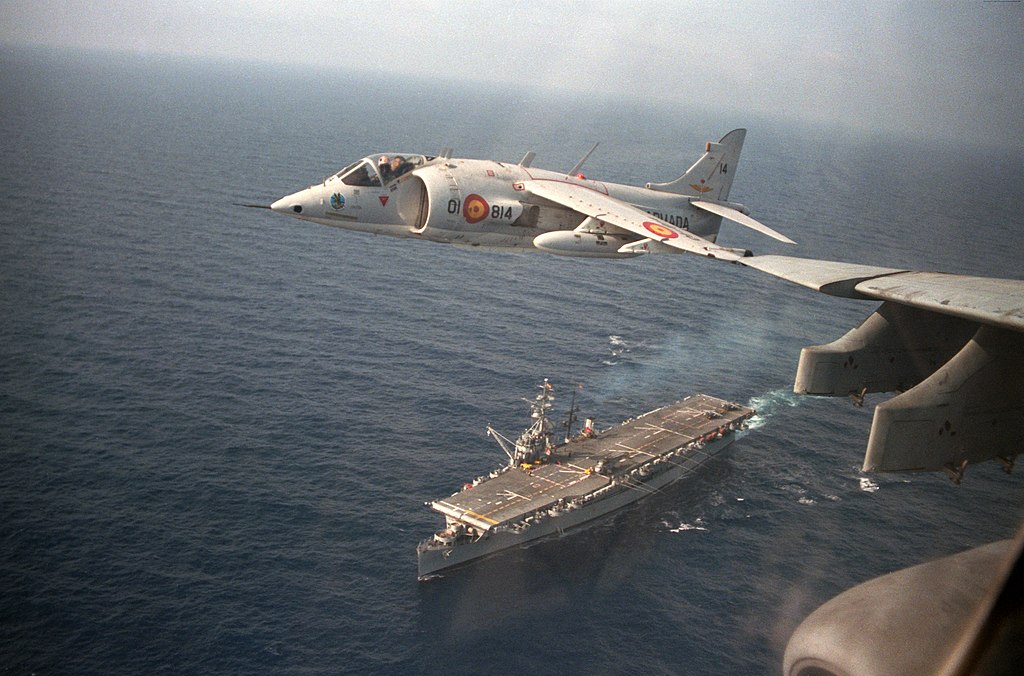
The previous Dédalo with a flyover by a Hawker Siddeley AV-8S Matador in June 1988
The ex-USS Cabot
The Independence class light fleet carriers
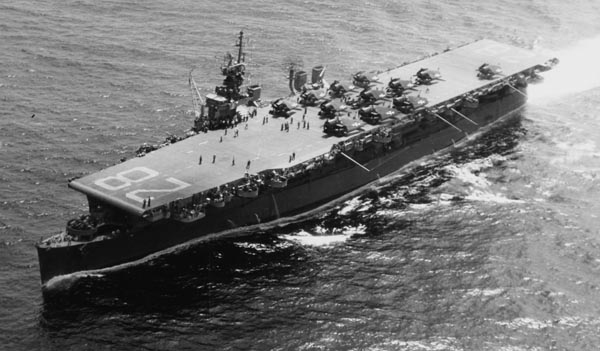
USS Cabot was a former Independence class light fleet carrier, one of ten ships ordered by president F.D. Roosevelt based on a Navy proposal as an interim solution for the completion of the new Essex class fleet carriers in 1942. Converted from Cleveland class light cruisers hulls, they provided indeed a quick solution, but were not liked by Navy top Brass, arguing of their poor air group, in WW2 30 aircraft. USS Cabot was commissioned on 24 July 1943, so after USS Essex was commissioned herself. Eventually the USN found ways to integrate these in TF 38/58 fast carrier fleet, instrumental for the Pacific Operations from 1943 to 1945. They served notably to provide local defensive CAPs (Combat Air Patrols) while the Essexes launched the main strikes away, their own fighters being used to escort torpedo-bombers.
USS Cabot (1943-1973)
With Air Group 31 USS Cabit only started her war from Majuro on 15 January 1944 with TF 58. Her operations in short were Roi, Namur, Truk (Marshalls campaign) and Yap, Ulithi, Woleai, Hollandia, Truk, Satawan, Ponape and the Mariana Islands campaign in June, the Battle of the Philippine Sea, as well as Iwo Jima, Pagan, Rota, Guam, Yap and Ulithi, Mindanao, Visaya, Luzon and the campaign of Okinawa, raids on Formosa, Battle of Leyte Gulf in October. On 25 November 1944 she was bafly hit by kamikazes. By December 1944 she attacked Luzon, Formosa, Indochina, Hong Kong, Nansei Shoto in the South China Sea, the Bonin islands, Iwo Jima, Kyūshū, Okinawa and had a long overhaul until June 1945. She earned 9 battle stars and presidential unit citation. After V-Day and “magic carpet” missions she was decommissioned in reserve at Philadelphia on 11 February 1947, had some service modified as a CVL in the cold war.
She made one tour of duty in European waters (9 January to 26 March 1952) and was decommissioned again, reserve fleet at Philadelphia on 21 January 1955. Reclassified AVT-3 on 15 May 1959 she was not recommissioned still.
The transfer
For context, the Spanish Navy in the 1960s was just rebuiding itself beween national constructions and MDAP provisions from the US. Despite Franco’s regime being an issue, preventing further integration into the European Community, pragmatism over anti-communism had the country eventually integrated into NATO in 1999, but well before that, the Armada took part in countless NATO exercises as external partner gradually intehrating the alliance’s procedures and tactics.
During the 1960s, Spain also experienced further increases in wealth. International firms established their factories in Spain which GDP and wages were well below the European level. Spain became the second-fastest-growing economy in the world alongside Brazil, just behind Japan, the “Spanish Miracle”. Thie also fuelled ambitions of the Armada, which acquired more ships with with still with a category lacking: The aircraft carrier.
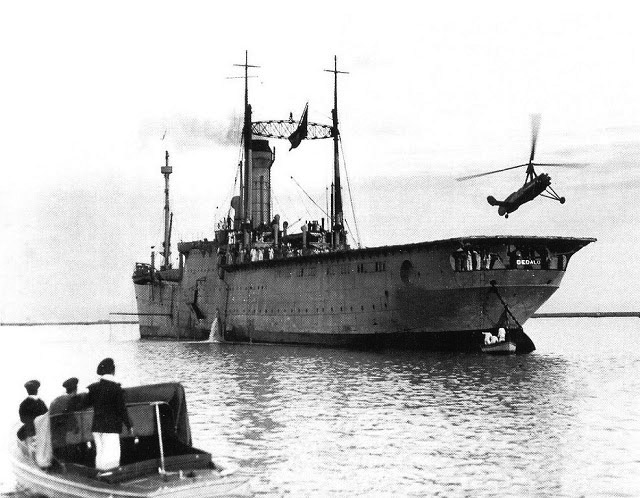
Dédalo (i) was the world’s first ship to operate autogyro.
The last one in service was Dédalo, first of the name, which served for two decades (1922-1940). She was designed in 1919 as a coaler conversion to take part in the Rif War (), and could carry six seaplanes and operate ballons aft. Obsolete, she was decommissioned in April 1936, but reactivated during the Civil War in Sagunto by Republican Forces, but she was not used eventually until the war ended in 1939. Under Franco there were some modernizatin projects, but due to the economic situation she stayed in definitively stricken on March 1, 1940. Towed to Valencia she was scrapped there. This left the new cold war navy without carriers for years.
In the late 1940s many British Light Fleet Carriers (1942 program) were on sale, but Spain still lacked the budget, and relations with the rest of Europe and the US, as the last extant axis member, had the country isolated. But it did not last long, as in 1950 the Congress passed a bill for a massive aid of 62.5 million dollars. Later the UN and Arab league and Latin american countries obtained a resolution to end sanctions on the regime and Spain was allowed to join the UN. The pact of madrid quickstarted a serie of MDAP in exchange of military bases in Spain, at Rota, Morón, Torrejón and Zaragosa, mostly for the air force (Rota was the go-to base for the USN). These Spanish bases became precious especially when De Gaulle back to power decided to leave NATO and expell US troops from France. The first US transfer were the two Lepanto class (ex-Fletcher destroyers, in 1957).
Between 1954 and 1961, the Armada personnel grew from 36,000 to 42,000 and the modernization of 30 Spanish ships prodeeded until 1963, while the Gearing inspired, USN weapons and radar Oquendo class (1963) was completed. Many more transfer will follow in the 1970s. But with four modern destroyers, Spain was now capable of providing escort to a capital ship or at least a flagship to replace the Cruiser Canarias on the long run (it was done from 1975).
So the USN took the initiative to propose to the Armada staff the loan (still under MDAP funding), of USS Cabot, in the mothballs at the time. The idea was to allow Spain to contribute its share of naval air operations, notably against Soviet submarines in the Atlantic and Mediterranean. At the time, the Spanish Naval Air force (Aeronáutica Naval, born 1920) had been dissolved in 1939 and was to restart from scratch. In the meantime the air force provided its needs.
Design of the class
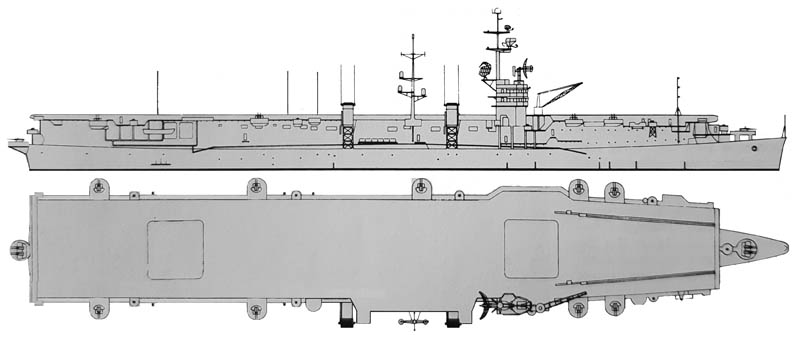
Main specifications
Dédalo as transferred was not different from the original USS Cabot, with only detail modernization compared to 1943 standards. She displaced 13,000 tonns standard, 16,416 tons fully loaded, measured 189.9 m in lenght overall, 21m.8 at the waterline for a 33.3 m width on deck level and a draught of 7.90m when fully loaded.
The propulsio was unchanged as well, as she kept four sets of General Electric geared steam turbines fed bt four Babcock & Wilcox boilers exhauting is small port deck side funnels.
Thus enabled a 100,000 shp output, procuring a top speed of 31 knts, always useful. Range was 7,500 nm at 15 kts based on 1,800 tons of fuel oil carried.
She had some armour protection, 127mm (5-in) of STS still on 16mm plating for the belt, and bulkheads also 5-in (127 mm) thick. Her main deck was limited to 2-in or 51 mm.
Her AA armament consisted still by 1967 of two quadruple 40mm/60 Mk 2 and nine twin 40/60 Mk 1 AA guns. Since she was reclassed and used as helicopter carrier prior transfer, she was setup and modified to carry and operate 28 helicopters (SH-3D, AB-212ASW, AH-1, CH-19).
Electronic suite was also modernized in the late 1950s, and she had the SPS-6, SPS-8, SPS-10 and SPS-40 radars, two Mk 28 fire control radars and two Mk 29 radars for her AA, plus the WLR-1 ECM suite. The crew amounted to 1,112 not including the air group, helicopter pilots and mechanics.
Facilities and Air Group
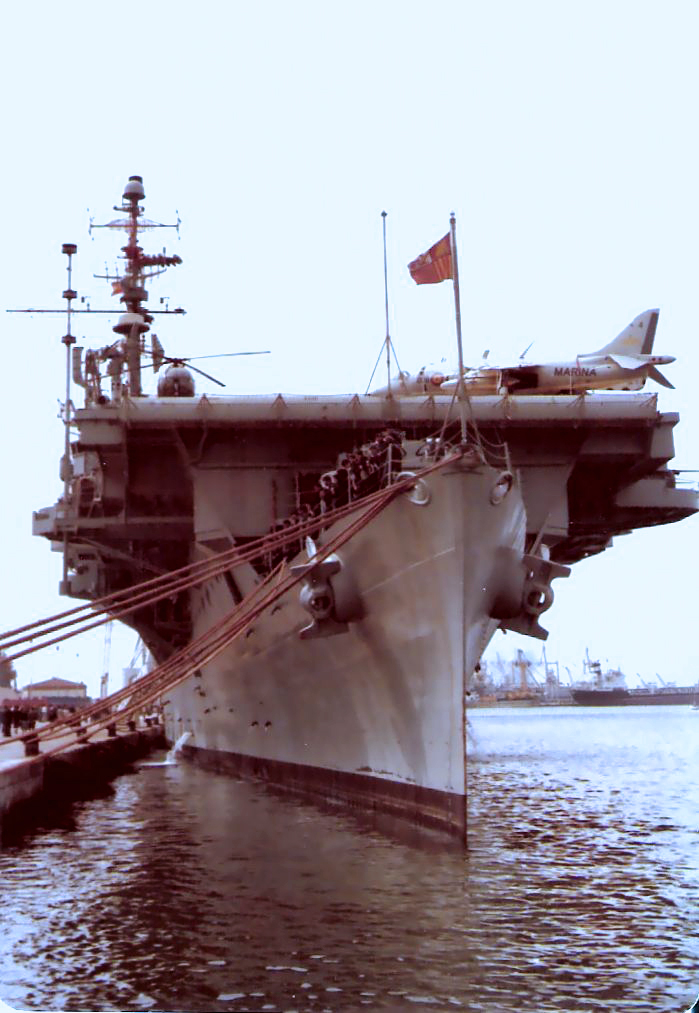
Dédalo’s 166.1 x 32.9 m flight deck was 3,773 m² in superficy, and the 78.6 x 16.7 x 5.3 m hangar represented an area of 1,313 m² and 6,957 m³ in volume. There were 2 lifts in center line with a 12.7 t capacity, 12.8 x 13.4 m in size. Aircraft fuel stowage was 462 700 l. Designed to operate WW2 piston engine models, these carriers were no way tailored to manage modern jets. To stay relevant they were converted as helicopter carriers which could fit inside (barely for the Sea Kings), giving them a total of 28, close to the original 30.
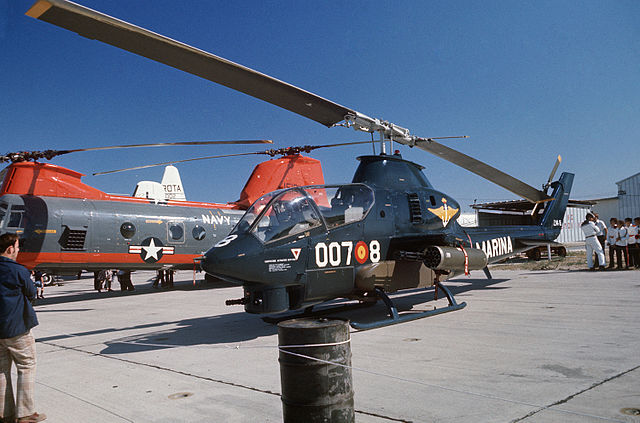
Spanish UH-1G Cobra, NAS Rota 1975
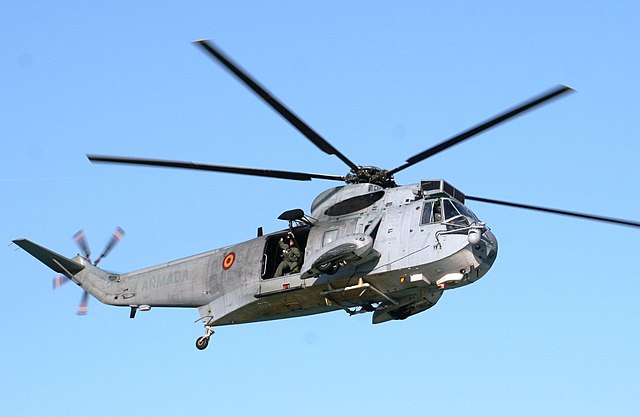
Spanish SH3D Sea King, Santander NAS
This air group comprised at first in 1968 eight SH-3D Sea King, four AB-204/212ASW, and four AH-1 Cobra, as well as four CH-19E Chickasaw. All these models were operated by the Spanish Navy, but also the Army for assault exercises. The Sea Kings provided the main ASW components, whereas the AB-204 could provided both transport and antiship support. The four Cobra and Chickasaw were the assault components, the first escorting the second.
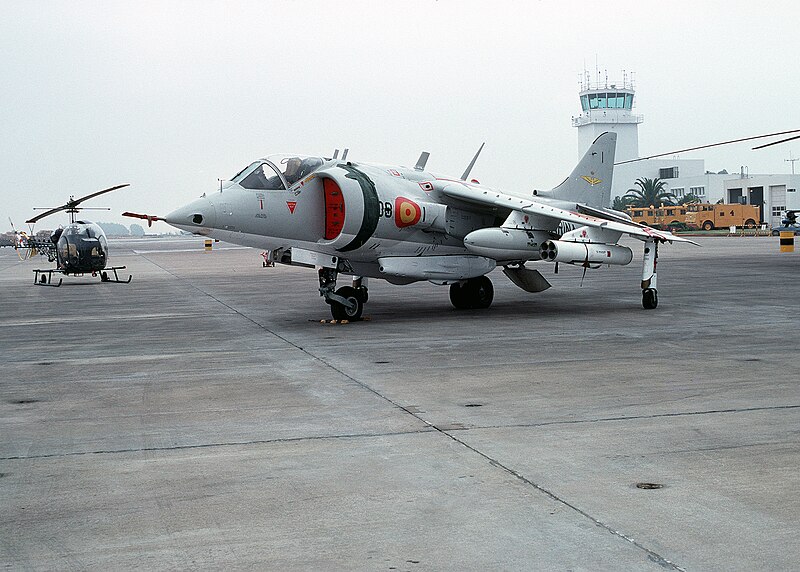
After the 1970s modernization, Dédalo obtained a brand new capability, to operate five AV-8S Matador, and one two-seat TAV-8A Matador. This came in addition to the helicopter group, amputed from the Chickasaw, but still comprising up to eight SH-3D Sea King, four AH-1 Hue Cobra, and four AB-212ASW.

Author’s rendition of the Hawker Siddeley AV8S Matador
The Hawker Siddeley Matador (the “S” in AV-8 stands for Spain) was in direct line of the 1969 British VTOL aircraft. Its top speed was Mach 1.17 (Mach 1.3 when diving) with a range of 1 hour 30 minutes in combat air patrol at 100 nmi (120 mi; 190 km) from the carrier. The payload was limited to two air-to-air missiles AIM-9 Sidewinder and its two 2× 30 mm (1.18 in) ADEN cannon pods, four rocket launcher pods or four iron bombs, BL755 cluster bombs or laser-guided bombs.
Modernization
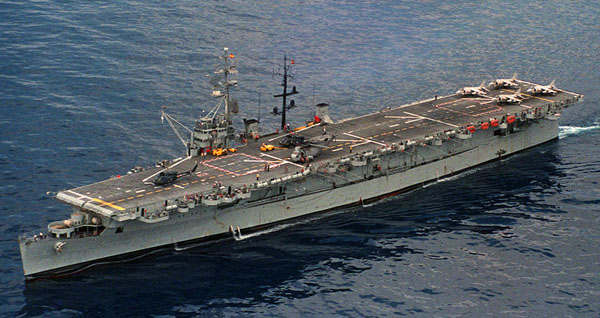
In 1973 Dédalo was purchased, after full modernization in the US, to the latest standards. Noth only her decks and lifts were strenghtened to operate the AV8B VTOL jet, but a new electronic suite was installed, all the electrical network was overhauled, power supply as well (ne generators), the intercom as well, and a new air conditioning system installed. The machinery was also overhauled but halved, so she had afterwards only wo funnels uptakes, speed down to 24 knots. The space freed enable to install larger gasoline and ammunition reserves, an extra workshops and accomodation to make her less cramped. Hangar capacity was however down to 20 aircraft. In the 1980s the ship returned to the US to have the Meroka CIWS installed.
⚙ specifications |
|
| Displacement | 13,000t standard, 16,416t FL |
| Dimensions | 182.9m/wl 189.9m oa x 21.8m wl 33.3m oa x 7.90m FL |
| Propulsion | 4 shafts GR steam turbines, 4 Babcock & Wilcox boilers, 100,000 shp |
| Speed | 31 kts |
| Range | 1800t oil, 7500 nm at 15 kts |
| Armament | 2x 4 – 40mm/60 Mk 2, 9×2 – 40mm/60 Mk 1, 28 helicopters (see notes) |
| Protection | belt: 127mm on 16mm plating, bulkheads: 127mm, main deck: 51mm |
| Sensors | SPS-6, SPS-8, 2x Mk 28 radars |
| Crew | 1112 + air group |
Career of Dédalo (1967-1989)
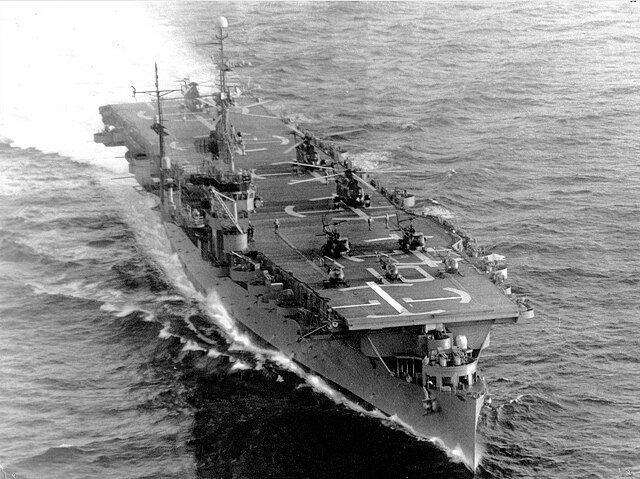
In 1953 already the Spanish government signed military agreements with the United States and studied options to incorporate a helicopter carrier or an aircraft carrier of US design conditioned by the MDAP aid. At some point the transfer of a Casablanca-class escort carrier USS Thetis Bay was considered. Later this went to an Essex-class aircraft carrier, USS Lake Champlain, but there were cost issues on the long run, notably to acquire the larger air group. Finally, some compromise was found on the acquisition of an Independence-class light aircraft carrier which on the US side was suggested as the USS San Jacinto).
Dédalo initially was deployed like the former USS Cabot, as helicopter-only antisubmarine warfare carrier (CVH), with her core being eight SH-3D Sea King completed by other helicopters of four types total. This air group varied widly between missions and exercises.
But 1967, after 12 years in mothballs, it’s USS Cabot that was chosen, and at first for loan, to Spain. US advisors went to Spain to help establish a routine operation and maintenance and the loan years went on after recommission 30 August 1967, for nine years. There was the question of returning her for a large replacement, but over the years, the naval staff estimated not to lose the benefit of hard training on board, the Spanish Government asked the US to transform the loan in purchase.
Under the command of Captain Francisco Javier de Elizalde y Laínez and accompanied by Ensign Luis Lozano Lozano, Dédalo (R-01) arrived in Spain on December 20, 1967, after crossing the Atlantic, from Philadelphia to Rota in seven days. The first loan term was only of five years.
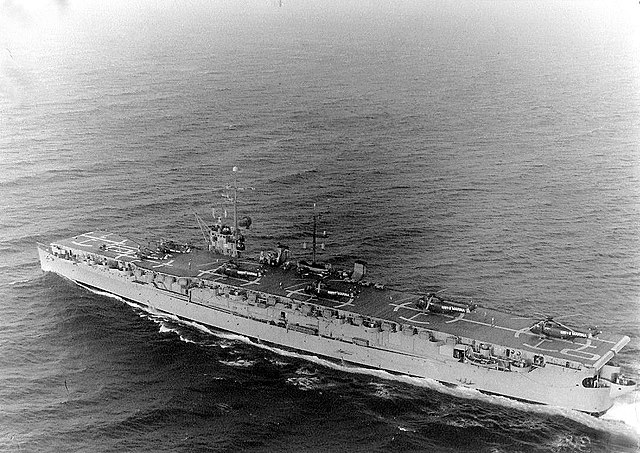
In October 1969, she took part in Spanish-French Faron IV exercizes off Barcelona, assisted by Juan Carlos de Borbón y Borbón, from the bridge of the Dédalo.
No precises records until 1972 when she was purchased.
For these early years in 1968-1972 she served only as helicopter carrier, as the ASW Spanish contribution against Soviet submarines and trade lines protection between the Azores and Baleares to the Western Mediterranean. She was acquired for this purpose. However on November 8, 1972, a test was performed, when a Av8 Harrier made a first short takeoff and vertical landing on her deck, followed by a series of tests showing her decks and lifts needed to be reinforced. This never had been done before on an Independence class ship. In December 1973 eight Harriers acquired in the United States made the new air combat core of the Spanish Navy and Dédalo, like her ancestor which first flew autogyro, she was the world’s first aircraft carrier to operate the Harrier in its aircraft complement, even before rebuilt British carriers. These trials were seen with great interest on both the USN and Royal Navy sides.

Dédalo and USS Raleigh, USS Saipan at Rota, 1982
Her new air group as expected comprised four parts, the ASW squadron made of four up to eight SH-3 Sea King, the ASW/EW squadron of four AB-204/AB-212 helicopters, a the “Assault group” combining the Bell AH-1 Cobra (7th Navy Squadron) and before 1976 as aletrnative, four Sikorsky S-55/CH-19E Chickasaw, also ASW helicopters. The fourth group was composed of five Harrier AV- 8A/S at sea plus a twin-seat model for training. On exercises, up to seven squadron could be operated between the hangar and flight deck as permament park.
So the modernization in the US helped her new status.
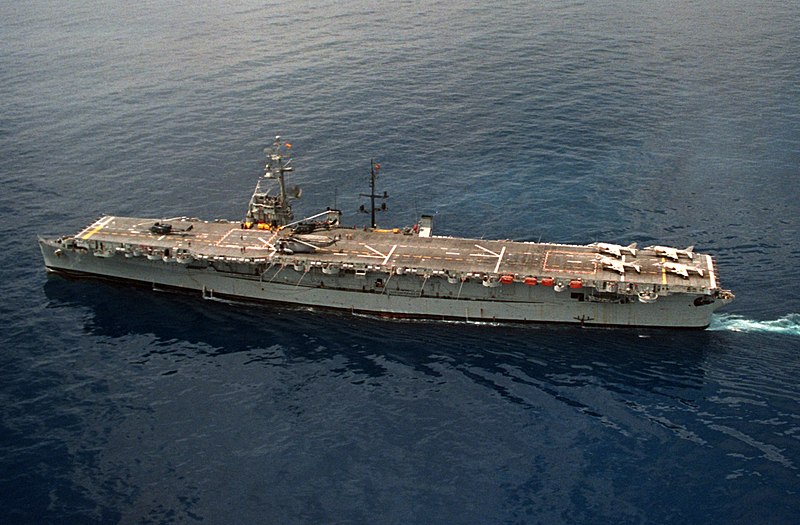
Dédalo underway in the Mediterranean, 1 June 1988
By October 1977, Dédalo took part in “Mar Canarias” manoeuvers off the Canary Islands. On August 9, 1978, she teamed with the frigates Baleares (F-71) and Extremadura (F-75), destroyers Lepanto (D-21) and Roger de Lauria (D-42) with the USS Shark in anti-submarine exercises off Cartagena. In November that same year she arrived in Cádiz to join other unnts and take part in ARDEX-78 between the 9th and 13th. This time she was reconfigured as an assault carrier, with a mock landing which took place at Carboneras beach.
In April 1980 she took part in naval maneuvers on the bay of Palma de Mallorca. By January 20, 1983, her helicopters rescued eight crew members from the Polish cargo Kudowa Zdroj sinking off Ibiza due to cargo shifting.
On May 14, 1986 while in the waters of Cartagena and helicopter (3rd Sqn.) collided with the ship’s communications mast during a night exercise. All three onboard died, with one more missing.
In June 1987 Prince of Asturias freshly completed and working out send her air group for training on board, and Dédalo took part in the large scale NATO Fleet-87 naval exercises in the mid-Atlantic.
Dédalo remained flagship of the Armada until definitive entry into service of Prince of Asturias (R-11).
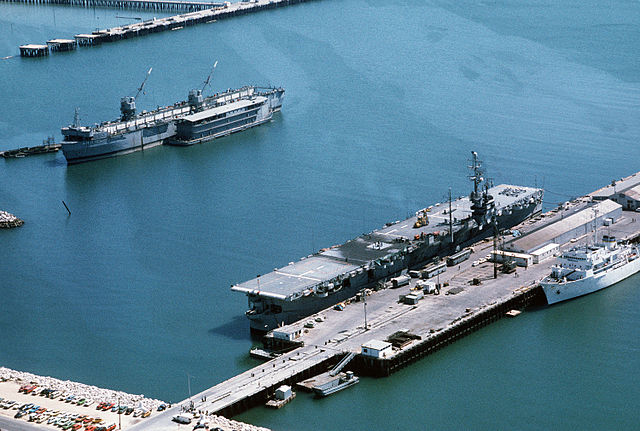
Dédalo at NS Rota 1976
She was to be replaced by the Principe de Asturias, then expected to serve alongside, but with the end of the cold war near, she was returned instead in 1989 to the US. Stricken in June 1989, she left Rota (Cádiz) on July 13, 1989, for the New Orleans, handed over to an American organization of former veterans of USS Cabot. The idea and agreement made with the Spanish Government, was to convert her into a museum ship and if possible trying to regain her WW2 appareance. Financial problems however in 1999 ruined these plans, and instead, she was auctioned, sold and scrapped in Brownsville, Texas in 2002. Only parts of the island and flight deck survived at the Naval Aviation Museum, NAS Pensacola in Florida. Her complete island survived until the Texas Air Museum at Rio Hondo closed.
Read More/Src
Books
Conway’s all the world’s fighting ships 1922-1947 and 1947-1995
Links
https://www.navalaviationmuseum.org/ pensacolas-flattops/
Aeronautica_Naval
USS_Cabot_(CVL-28)
es.wikipedia.org dedalo
navypedia.org/ dedalo2
en.wikipedia.org/ Spanish_aircraft_carrier_dedalo
web.archive.org/ R01+Dedalo
blognaval.es/otro-portaaviones-dedalo/
los-huey-cobra-de-la-armada-espanola
usscabot.com/
El portaeronaves ‘Dédalo’ regresa a EE UU tras ser cedido a un grupo de ‘marines’
Cómo los Pactos de Madrid entre Franco e Eisenhower de 1953 impulsaron a la (casi inexistente) Armada española
abc-madrid-19771030-5.html
shipsnostalgia.com
Videos
1977 Defensa de las Islas Canarias – Portaaviones Dédalo, Harrier, Armada Española “Mar Canarias”
Model Kits
No precise kit found, but any modification of a regular Independence class kit would do




 Latest Facebook Entry -
Latest Facebook Entry -  X(Tweeter) Naval Encyclopedia's deck archive
X(Tweeter) Naval Encyclopedia's deck archive Instagram (@navalencyc)
Instagram (@navalencyc)





 French Navy
French Navy Royal Navy
Royal Navy Russian Navy
Russian Navy Armada Espanola
Armada Espanola Austrian Navy
Austrian Navy K.u.K. Kriegsmarine
K.u.K. Kriegsmarine Dansk Marine
Dansk Marine Nautiko Hellenon
Nautiko Hellenon Koninklije Marine 1870
Koninklije Marine 1870 Marinha do Brasil
Marinha do Brasil Osmanlı Donanması
Osmanlı Donanması Marina Do Peru
Marina Do Peru Marinha do Portugal
Marinha do Portugal Regia Marina 1870
Regia Marina 1870 Nihhon Kaigun 1870
Nihhon Kaigun 1870 Preußische Marine 1870
Preußische Marine 1870 Russkiy Flot 1870
Russkiy Flot 1870 Svenska marinen
Svenska marinen Søværnet
Søværnet Union Navy
Union Navy Confederate Navy
Confederate Navy Armada de Argentina
Armada de Argentina Imperial Chinese Navy
Imperial Chinese Navy Marinha do Portugal
Marinha do Portugal Mexico
Mexico Kaiserliche Marine
Kaiserliche Marine 1898 US Navy
1898 US Navy Sovietskiy Flot
Sovietskiy Flot Royal Canadian Navy
Royal Canadian Navy Royal Australian Navy
Royal Australian Navy RNZN Fleet
RNZN Fleet Chinese Navy 1937
Chinese Navy 1937 Kriegsmarine
Kriegsmarine Chilean Navy
Chilean Navy Danish Navy
Danish Navy Finnish Navy
Finnish Navy Hellenic Navy
Hellenic Navy Polish Navy
Polish Navy Romanian Navy
Romanian Navy Turkish Navy
Turkish Navy Royal Yugoslav Navy
Royal Yugoslav Navy Royal Thai Navy
Royal Thai Navy Minor Navies
Minor Navies Albania
Albania Austria
Austria Belgium
Belgium Columbia
Columbia Costa Rica
Costa Rica Cuba
Cuba Czechoslovakia
Czechoslovakia Dominican Republic
Dominican Republic Haiti
Haiti Hungary
Hungary Honduras
Honduras Estonia
Estonia Iceland
Iceland Eire
Eire Equador
Equador Iran
Iran Iraq
Iraq Latvia
Latvia Liberia
Liberia Lithuania
Lithuania Mandchukuo
Mandchukuo Morocco
Morocco Nicaragua
Nicaragua Persia
Persia San Salvador
San Salvador Sarawak
Sarawak Uruguay
Uruguay Venezuela
Venezuela Zanzibar
Zanzibar Warsaw Pact Navies
Warsaw Pact Navies Bulgaria
Bulgaria Hungary
Hungary

 Bundesmarine
Bundesmarine Dutch Navy
Dutch Navy Hellenic Navy
Hellenic Navy Marina Militare
Marina Militare Yugoslav Navy
Yugoslav Navy Chinese Navy
Chinese Navy Indian Navy
Indian Navy Indonesian Navy
Indonesian Navy JMSDF
JMSDF North Korean Navy
North Korean Navy Pakistani Navy
Pakistani Navy Philippines Navy
Philippines Navy ROKN
ROKN Rep. of Singapore Navy
Rep. of Singapore Navy Taiwanese Navy
Taiwanese Navy IDF Navy
IDF Navy Saudi Navy
Saudi Navy Royal New Zealand Navy
Royal New Zealand Navy Egyptian Navy
Egyptian Navy South African Navy
South African Navy






























 Ukrainian Navy
Ukrainian Navy dbodesign
dbodesign